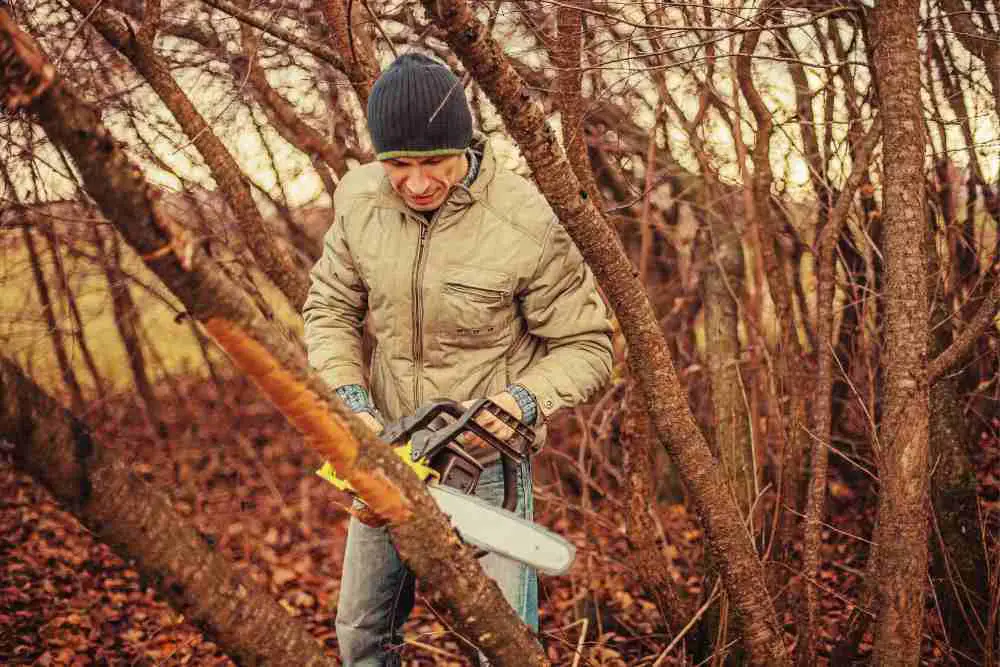To start a flooded chainsaw, you need to carefully follow the manufacturer’s instructions for the specific model. A flooded chainsaw can be started by first removing the spark plug and then pulling the starter cord several times to clear excess fuel from the cylinder.
A flooded chainsaw occurs when too much fuel enters the combustion chamber, preventing the engine from igniting. If you find yourself in this situation, don’t panic. By following a few simple steps and taking the necessary safety precautions, you can start a flooded chainsaw and get back to work in no time.
We will guide you on how to start a flooded chainsaw safely and efficiently, ensuring smooth operation of your powerful cutting tool. So, let’s dive into the details and get your chainsaw running again.

Understanding The Basics Of A Flooded Chainsaw
Understanding the basics of a flooded chainsaw is essential before attempting to start it. To begin, let’s take a look at the fuel system overview. The fuel system consists of a fuel tank, fuel lines, carburetor, and air filter.
Several factors can cause a chainsaw to flood, including excessive priming, a clogged carburetor, or a faulty spark plug.
Signs of a flooded chainsaw are usually evident when the engine fails to start or starts but quickly stalls.
A flooded chainsaw may also exhibit a strong smell of gasoline or thick black smoke coming from the exhaust. It’s important to address a flooded chainsaw promptly to prevent further damage.
Step-By-Step Guide To Starting A Flooded Chainsaw
Assess the situation before starting a flooded chainsaw to prevent further damage. Gather the necessary tools and equipment for the procedure. Start by clearing the flooded engine using the correct technique. Next, check the spark plug to ensure it is functioning properly.
Adjust the choke and throttle settings according to the chainsaw’s specifications. Finally, start the chainsaw using the recommended starting procedure to avoid any mishaps.
Best Practices To Avoid Flooding Your Chainsaw
Starting a flooded chainsaw can be a frustrating experience for anyone. To avoid this issue, it is crucial to follow best practices. The first step is to ensure the proper fuel mixture and usage. This means using the correct ratio of fuel and oil, as specified by the manufacturer.
Regular maintenance and cleaning are also essential. Keep the chainsaw clean from debris and inspect the spark plug regularly.
Lastly, correct storage procedures are crucial to prevent flooding. Before storing the chainsaw, make sure to empty the fuel tank and run the engine until it stops.
Additional Tips And Considerations For Starting A Chainsaw
Starting a flooded chainsaw can be a challenging task, but with some additional tips and considerations, you can make the process easier.
One method you can try is using starting fluid, also known as ether. Before doing so, it is important to note that starting fluid should be used sparingly and as a last resort, as it may cause damage to your chainsaw.
If you are unsure or uncomfortable with starting the chainsaw on your own, it is always best to seek professional help.
Safety should be a top priority, so make sure to wear protective gear, including gloves and goggles, and follow all necessary precautions while starting the chainsaw.
Common Mistakes To Avoid When Starting A Flooded Chainsaw
Starting a flooded chainsaw can be tricky, but there are common mistakes you should avoid. Over-priming the engine can lead to excessive fuel, making it harder to start.
Neglecting maintenance and repairs can contribute to a flooded chainsaw. It’s important to regularly check and clean the spark plug, air filter, and fuel system.
Additionally, forcing the chainsaw to start by repeatedly pulling the starter cord can cause further flooding. Instead, follow the manufacturer’s instructions for starting the chainsaw.
Hold the throttle fully open, engage the choke, and pull the starter cord with slow, even strokes.
If the chainsaw doesn’t start after several attempts, wait a few minutes to let excess fuel evaporate before trying again. Remember, starting a flooded chainsaw requires patience and proper technique to ensure a smooth start.
FAQs
How Do You Unflood A Chainsaw Quickly?
To quickly unflood a chainsaw: 1. Turn off the chainsaw and remove the spark plug. 2. Clean the spark plug and let it dry. 3. Pull the starter cord several times to remove excess fuel. 4. Reinstall the spark plug and start the chainsaw.
How Do You Start A Chainsaw With A Flooded Engine?
To start a chainsaw with a flooded engine, follow these steps: 1. Remove the spark plug. 2. Pull the starter cord a few times to expel excess fuel. 3. Clean or replace the spark plug. 4. Reinstall the spark plug and try starting the chainsaw again.
How Long Does It Take A Flooded Chainsaw To Start?
A flooded chainsaw can take some time to start, usually a few minutes.
How Do You Know If You Flooded Your Chainsaw?
If your chainsaw is flooded, it may be difficult to start or there may be excessive smoke from the exhaust.